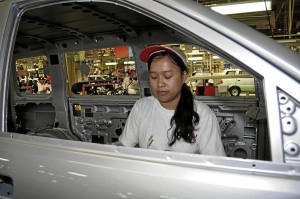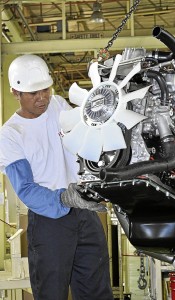Keeping the wheels of industry turning
It is interesting to note that some of the fastest, the most expensive as well as the plushest ride on the planet are still hand-built.
Throughout the manufacturing process of, say, the Rolls-Royce Ghost, the Bugatti Veyron or the Ferrari 458 Spider, there will always be someone at every stage of the process, doing the assembling, installing or fitting of parts.
Which is why this writer was a bit delighted upon seeing rows of technicians and engineers manning the stations of Isuzu Philippines Corp.’s assembly plant in Biñan, Laguna.
Yes, the Crosswind AUVs, D-Max pick-ups, as well as light- (N-Series) and medium-duty (F-Series) trucks that come out of this particular assembly line, may not be the priciest or the rarest moving masterpieces of luxury. But the mere fact that these models were created through experienced and skilled hands is more than enough to make anyone satisfied.
Prefers people
“Robots are fine but we prefer highly skilled people. They are like artists so much so that I regard each Isuzu vehicle that comes out of this plant as rolling work of art,” IPC EVP Takashi Tomita said.
But while almost everything here is fitted to the vehicle by hand, IPC has done everything it can to make life easier for the technicians and engineers.
“Of course, the heavy body parts are picked up by giant cradle if not laid on railed carts that are carried around the assembly hall. They enable the heavy parts to be raised, lowered or swiveled by the technician being fitted. Stooping or straining is no longer necessary,” IPC VP for manufacturing Koichi Tamura said.
Wonderful sight
Indeed, it was wonderful to see how an entire drivetrain, containing the engine, gearbox, drive shafts, as well as the suspension and brakes, is assembled outside the vehicle’s steel shell, and driven to meet the body using a cart that moves through rails.
As our group observed, these technicians work with such finesse that one would think their job is easily accomplished by anyone.
Which is why when Isuzu planned to “insert” us into the assembly line for “A Day at Isuzu” event, some of us had some hesitation considering this would be the first time we will be operating the tools and equipment employed in the assembly of Isuzu’s light- and medium-duty trucks.
In fact, this was also in the mind of the engineers at the assembly line.
Convenient and safe
Considering the months and years that IPC technicians spent in mastering their assigned work as well as the intricacies of operating the machine and equipment used in the assembly area, Tamura as well as Quality Control officer, engineer Angel Cells Jr., rightfully decided that it would be much more convenient as well as safe to just let us visitors to closely observe the process.
I particularly welcome the idea considering I have no intention of breaking IPC’s zero accident days record or even alter the exceptional build quality of the light- and medium-duty trucks that come out of this ISO 14001:2004-certified plant.
Adhered

A PRODUCT of the Isuzu-Technical Education and Skills Development Authority Automotive Training Center in Tacloban, Yniezza Nina Mosot finds herself at home in this male-dominated work area.
Nevertheless, I still enjoyed the newly assigned task. It felt great that IPC still adhered to maintaining local operations, thus promoting domestic auto manufacturing and jobs generation.
“For ‘A Day at Isuzu’ event, we have chosen to feature our workhorse trucks considering they are, literally and figuratively, vehicles that move the Philippine economy forward. These trucks are vital to our nation’s economic prosperity and play a significant role in mitigating adverse economic effects during a national or regional emergency. Our economy depends on trucks to deliver million tons of virtually every commodity consumed,” Tomita explained.
No wonder, Isuzu’s N-Series has been the country’s best-selling light-duty commercial truck since 1999, a record run of 13 years straight.
Tomita reported that just last year, the N-Series captured 69.4 percent share of the country’s Light-Duty Truck segment after selling 1,196 units, a great improvement from 2010’s 1,030 figure (67.1 percent market share).




